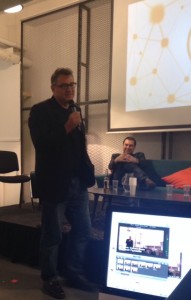
SUMMARY: Where is Bitcoin 2.0 Heading?
Jon Matonis
Is Bitcoin in fact the greatest revolution in computing since the Internet itself?
VIDEO OF THE EVENT
It’s a much deeper concept than currency. It’s the idea of distributed trust.
In 20 years, we’ll talk about Bitcoin like we talk about the Internet today, We just need time for it to play it out.
– Marc Andreessen (VC and founder of Netscape)
As VCs rush to fund start-ups that use Bitcoin’s Blockchain technology, we asked: will Bitcoin’s real innovation, its platform, really build completely new ways of interacting online? What are the next generation of apps?
Advocates argue that the Blockchain has the capacity to address not simply money issuance but other crucial questions of trust, financial privacy , transparency, and freedom of expression.
Tuesday June 24th 2014.
SUMMARY
What have we learnt from Bitcoin and where is it heading?
Despite massive fines for Libor and gold price manipulation, poor quality flotations and constant shortcomings of honest trading practices, means the top 4 UK banks are still carrying on paying large bonuses but not lending to SMEs. Competition by new banks is stifled by large capital requirements skewed towards large banks. This is what stops the incoming new banks from making any inroads into efficient and wide-spread lending.
Cybersalon invited a number of thought leaders on alternative finance to explore our options to improve the flow of finance and support innovators bottom-up.
We called the event ‘The Future of Bitcoin 2.0’ and Jon Matonis, who heads up the Bitcoin Foundation was quick to correct us. He noted that Bitcoin is still in the early stages of pre 1.0 release and his time horizons for upgrade are certainly much longer than we estimated.

He noted that Bitcoin is the biggest distributed computing project in the world, its combined power reaching 5000 supercomputers. To just explain the process, he said that the blockchain is the underlying technology that powers Bitcoin, a decentralised ledger, where every transaction is recorded on every full node.
If you are running Bitcoin, you will have a record of every transaction, which will be held in sync with those of everyone else in the network. The blockchain is the glue that keeps the whole network coordinated and in consensus.
The Bitcoin network allows the transfer of value between two trusted parties who don’t need an intermediary like a bank to validate the transaction. It opens up the opportunities for a global currency that can support global peer-to-peer exchange of goods as well as services.
Jon Matonis described his first encounter with the cryptocurrency when Satoshi send him an email in 2009, inviting him to test it and to get into mining. Previously an author of Monetary Futures blog, Matonis has spend a few years in payments technology like Visa, and focuses on engaging the banks to recognise Bitcoin as a “foreign currency”.
The problem he notes is the excessive holdings of Bitpay and CoinDesk, who are therefore large net sellers. To improve the fluidity, the Bitcoin Foundation is aiming to enhance standardised protocols, quality assurance and testing, focus on enhanced banking for the unbanked. He noted the key attraction of the Bitcoin is still the ability to send funds cross-border without charges.
One of the main roles of the Foundation is to raise money to pay developers to develop Bitcoin and to be a respectable face to Bitcoin. They try to enable standards and gain acceptance amongst third parties and legal entities to accept and understand Bitcoin.
For Jon, Bitcoin is way ahead of its time and the guys building Blockchain apps that will be talking after him (dubbed Bitcoin 2.0) are even further ahead. Although they sound sexy, are a long way off being ready for market or the market being able to understand them.

Niki Wiles from Counterparty focused on how the blockchain can disrupt centralised systems, and which industries are most likely to ‘fall’ first. Bitcoin’s eco system works where each peer on the network can be a bank. Instead of using the third party validators like Banks, blockchain protocol can open innovation in any area where trust can be built without mediators as the network is validating it as a whole.
The industries ripe for innovation are also where coordination of the trust implementation is difficult or expensive. Examples of potential decentralised models could be replacing today’s centralised organisations like Uber, AirBnb, eBay as well as Facebook and Dropbox.
As storage, memory and processing power become cheaper, the block chain will allow decentralisation of increasing amount of services that today need centralised organisation.
Most organisations are centralised and therefore they have high propensities for failure in the form of for fraud, corruption, invasion of privacy, price rigging, preferential treatment for “insiders” (see IPO process where large investors get a bite at lower prices), closed platforms and many others. Post Satoshi’s invention of the Blockchain, the costs and ease-of-use of decentralised organisation models are falling rapidly.
He also noted in a slide titled ‘Evil Blockchain’ that there are risks to distributed computing, when they can be used negatively. We should be putting in place frameworks that can pre-empt them and prevent hi-jacking of computer-mediated trust platforms falling in the wrong hands.
Counterparty offers a layer on top of the Blockchain protocol, and a suite of tools to balance the excessive demand, allowing hedging as long as data is available. Counterparty offers the tools to open peer-to-peer marketplaces by putting financial tools into the hands of everyone with an internet connection. Power to the people!
Niki suggested Satoshi’s invention is of enough importance to win the Nobel prize as it gives us an option to self-organise ourselves. We can now use the network as the validator of our actions and decentralisation as the primary form of self-organisation.
We should be looking at decentralisation models for voting and ID/Reputation not just finance and currencies. The current Decentralisation Heroes are DNS (Namecoin), Notary (Proof of Existence), Messaging (BitMessage), Social Networks (Twister), Finance/Markets (Counterparty), Contracts (Ethereum), Gambling (ChanceCoin), Storage (Storj), the last one having a lot of potential as privacy concerns increase in regard to Dropbox and similar centralised models.
The targets for decentralised organisations are travel (autonomous vehicles), telcos (to be replaced with meshnets owned by the users and not by the central supplier), manufacturing (3D printers and people making their own products). Where infrastructure can be owned by large number of people, Blockchain is the solution.

Stephan Tual from Ethereum noted that decentralised apps technology are hard for people to build themselves and so he is offering a solution to address it. Ethereum is an open source platform to write and distributed next generation applications that are decentralised. These so-called ‘trustless’ operations are expensive, and applications developed on Ethereum will not require their users to trust the developers to take care and secure their personal information or funds. Instead they will provide trust through the algorithm and the network who will verify the transactions for us.
On Ethereum, what’s yours- this can be funds, your personal data or your photos – stays yours.
Therefore you can create apps with no middlemen, enabling users to interact with social networks, financial systems, voting mechanisms and games in a completely peer-to-peer fashion. Ethereum will be distributed on computers all around the world, all of this taking place on a censorship-proof system. Just like Bitcoin leverages this technology to keep your funds safe, it will be easy to make applications, and leverage common languages such as HTML, Javascript, to build interfaces, and Python, Lisp or Go to write the business logic.
He also noted the potential uses of it, as a hotel booked on Ethereum will automatically unlock the room once the payment has been received by sending a code to the user.
Time to market – estimated end of 2014. Stephan showed some new images of the Ethereum interface, not previously seen.
He recommended using Ethereum to build alt coins, which may have zero value but at this early stages it is the gaining the experience and educating the public as its main focus. For example, digital artists can issue their own alt coins, so people own part of the work. He compares it to Swarm, a decentralised Kickstarter, but for individuals.
The next speaker was Ben Ingram from Swarm who has just raised $1m through crowdfunding for their initiative. Ben is a seasoned entrepreneur and says he is fed up of the VC and IPO ‘flipping company’ model. He is trying to build a new form of entrepreneurship through crowdfunding. But unlike Kickstarter and IndieGogo, investors actually own a part of the company. VCs are however starting to invest in Blockchain companies, so Swarm offers an alternative to this.
Some members of the audience questioned the fact that Bitcoin is democratic, saying that it is a hardware arms race and those with the biggest machines win, as they can mine Bitcoin successfully. Others say that Bitcoin is actually centralised due to The Foundation ‘running things’. There was a discussion amongst the panel as to whether Bitcoin was more useful than simply providing Blockchain technology, and whether the currency was actually sustainable. They thought it was something that will be here to stay due to its network effect, despite many more digital currencies being launched.
The event sponsor, hydro 66, talked about their new data centre as being fully sustainable and based in the Arctic Circle in Sweden, thereby needing minimal cooling. All the electricity is generated through hydro-electric power by a river, making both their collaborative Bitcoin mining and hosting solutions totally green.
The Internet as currently is, is not fit for purpose for what we want to use it for today. It was built for sharing academic files. Bitcoin is going through what the Tim Berners-Lee’s World Wide Web went through in the early 1990s. It was considered over simplistic but spread due to its ease of use. Blockchain technology is filling in the gaps left by the early Web by providing peer to peer transactions and a decentralised trust platform.
Speakers:
 Jon Matonis- Executive Director, The Bitcoin Foundation
Jon Matonis- Executive Director, The Bitcoin Foundation
A money researcher and crypto economist from George Washington University, Jon advises startups in Bitcoin, gaming, mobile and prepaid organizations. A tech contributor to Forbes Magazine and editor of The Monetary Future, Jon serves on the editorial board of Bitcoin Magazine. Previously CEO of Hushmail and Chief Forex Trader at VISA and held senior posts at Sumitomo Bank and VeriSign.
 Stephan Tual- Chief Communications Officer, Ethereum
Stephan Tual- Chief Communications Officer, Ethereum
Ethereum is “Cryptocurrency 2.0″. It’s a decentralized mining network and software development platform rolled into one, and it will allow people to create their own altcoins, and other types of crypto.
Niki Wiles -Community Relations, Counterparty
Counterparty is a peer-to-peer finance platform and decentralized exchange built on Bitcoin. He has been involved with distributed finance since the early days of Bitcoin, and has an eclectic background in IT, finance and marketing.
 Ben Ingram, COO, SWARM– decentralised crowdfunding
Ben Ingram, COO, SWARM– decentralised crowdfunding
Ben is a mainstream entrepreneur. Post sale of his strategic consulting and system integration company (named the most recognised brand in Cloud software services), Ben had the opportunity to once again look for the ‘next big thing’. His startup Swarm is a revolutionary approach to enterprise capital & their new model for distributed crowd funding is the talk of the internet. “This, right now, is the moment, when crypto equities emerge as the most profoundly impactful technology of this century. In 2014, progressive VC portfolios will be built on the blockchain.” SWARM is a new approach to crowd funding that uses Blockchain technology to outpace traditional platforms like Kickstarter and which aims to accelerate the evolution of the crypto-currency community and explore the possibilities of issuing new crypto-tokens. They recently launched to a warm reception, raising close to £1m in a week.
 Chair: Richard Boase, Cybersalon/UK Digital Currency Association
Chair: Richard Boase, Cybersalon/UK Digital Currency Association
There is no reason on earth for anybody to be on the Internet today to be typing in a credit card number to buy something. But we didn’t have the better way of doing it. So we didn’t know what else to do…now we have the better way of doing it. Bitcoin.
– Andreessen
However critics claim that the anonymity inherent in the Bitcoin system means it encourages money laundering, gambling and drug dealing. They also point to its wild volatility as evidence that it functions as a poor store of value that will make economic activity ultimately less productive.
JOIN OUR MEET UP GROUP
Background
Bitcoin (which is now known as a “Crypto currency” or Hidden Currency) has fluctuated from $0.0001 to US $1,200 in the span of 5 years. Advocates cite its capacity to be a truly global, digital currency- to lower remittance and cross border transfer costs particularly with regards to developing economies and its power to remove politics from the money supply. Its main attraction, they claim, is that all other banking and monetary systems are ‘pre-internet’ technologies but Bitcoin offers us the potential to build an entirely new system of global financial consensus, even acting as a global reserve currency.
About Bitcoin 2.0
The value of the Bitcoin platform is that it can be used for other means than as a currency: for instance to transfer goods directly from person to person around the planet securely without third party verification. The way Bitcoin does this is through what is known as a peer to peer network, with these transactions being verified automatically by thousands of so called ‘Miners’. Bitcoin is not a company, and whilst Miners might act like employees, it was designed as an open standard protocol similar to http (web pages) or smtp (email), allowing anyone who wishes to to build companies, services and software to interact with it, and because Bitcoin functions a little bit like TCP/IP, owning a Bitcoin is akin to owning real-estate on the new internet, similar in some ways to owning name brand dot coms in the ‘90s.
Essential Reading
Bitcoin 2.0- opening the pathway to decentralised trust and the democratisation of power – by Ami H. commissioned for Cybersalon
Swarm: The Facebook of Crowdfunding – Richard Boase published on CoinDesk
Understanding Eris: The Bitcoin Foundation Proposal – Clay Micahel Gillespie published on Crypto Coins News
The Coming Digital Anarchy– Matthew Sparkes published in The Telegraph
Tomorrow’s Apps Will Come From Brilliant (And Risky) Bitcoin Code – Primavera De Filippi published on Wired
Why The Bitcoin Fad Won’t Fade Away– Jeffrey Tucker published on The Daily Reckoning
Visions of a Techno- Leviathan:The Politics of the Bitcoin Blockchain– Brett Scott published on E-International Relations
Warren Buffett versus Marc Andreessen on Bitcoin– Kashmir Hill published on Forbes
FXCM has created this informative visual.
Tuesday June 24th 2014, 7pm, Digitas LBi, 146 Brick Lane, London E1 6RU
We now accept Bitcoin!

